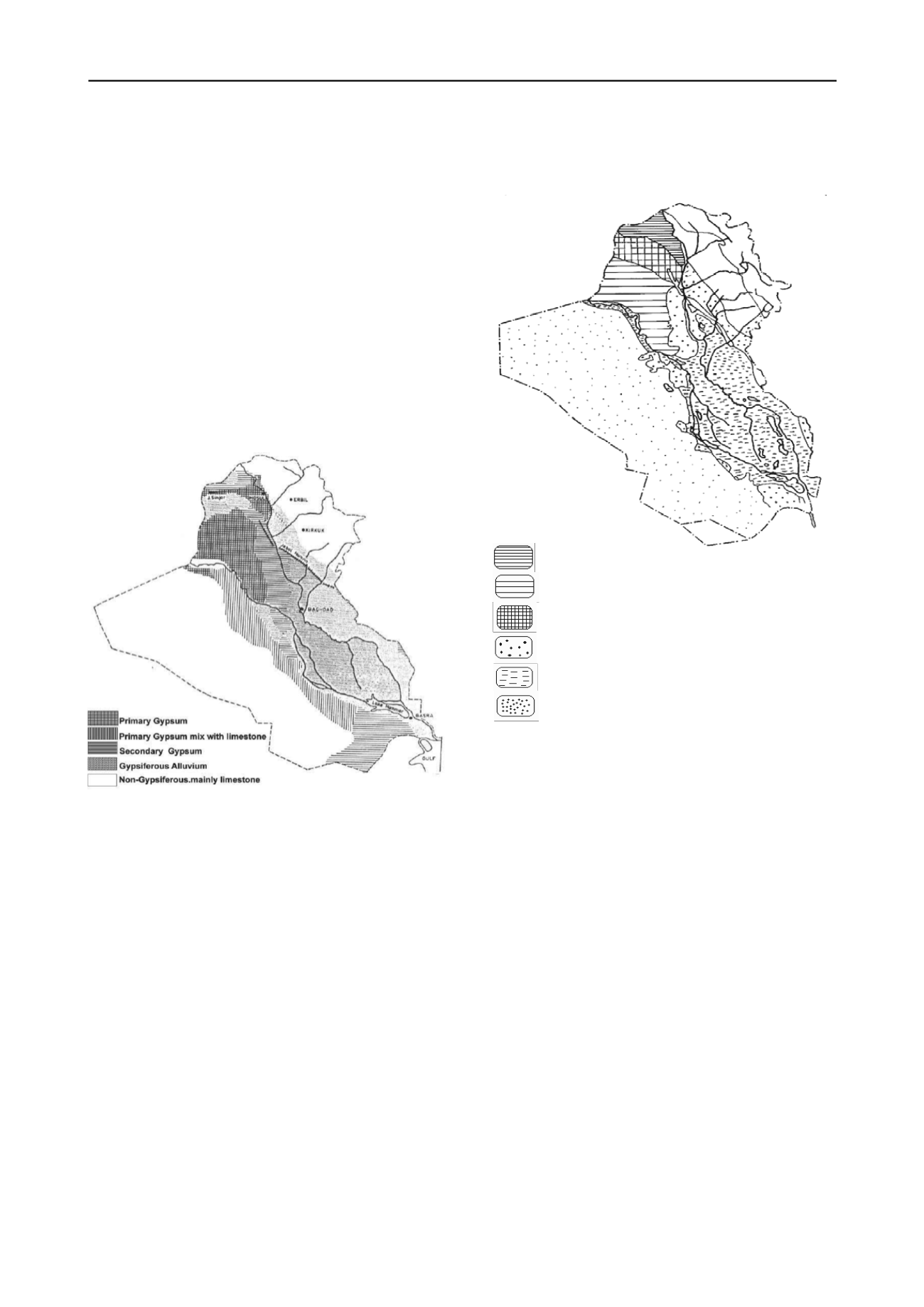
480
Proceedings of the 18
th
International Conference on Soil Mechanics and Geotechnical Engineering, Paris 2013
2. DISTRIBUTION OF GYPSEOUS SOILS IN IRAQ
Gypseous soils exist mainly in arid and semi arid regions,
concentrates in contenents like africa,central and souther asia.
Iraq is among the contries of south asia where gypsum covers
about 12 % of its total area. (FAO 1990), although more recent
study (Ismail 1994) reported that gypseous soils cover 31.7 % of
the total area of iraq.the first map demonstrating the distribution
of gypsum in iraq was presented by (Buringh 1960) indicating
five zones as shown in figure 1. The primary gypsum is located
in the extreme north area between tigres and euphraties rivers.
The second zone where primary gypsum mixed with limstone
located below and parrallel to the euphraties river extending
from the west desert to the south. The secondary gypsum is
identified in two areas, one in the north below the first zone and
one in the south – west. The fourth zone is gypsiferous alluvium
extens from the north in a narrow band and gradually widened
towards the south. The fifth zone representing the non
gypsiferous soil, mainly limestone is identified in two ares one
in the north east and the other in the west desert.
Figure 1 first map of distribution of gypsum in iraq
A more refined map exhibiting the distribution of gypsum in
iraq was presented by (Al-Barrazanji 1973). He investigated
thoroughyl the type and gypsum content in different parts of
iraqand proposed the map shown in figure 2.Six zones are
distiguished according to their origin and gypsum content.Zone
one of slightly gypseous over gypsum bedrock denoted by nar-
row parallel lines taking the shape of a triangle in the upper
north of Iraq. The second zone is of moderately to highly gyp-
seous soils over gypsum and anhydrate rock denoted by wider
parallel lines, located in the north part between the Tigress and
Euphrates rivers. Zone three is gypsum desert denoted by a mesh
of small squares, located between zones one and two in the
north. Zone four contains highly gypsiferous soils on Pleistocene
terraces covering two narrow strips on the left and right of Ti-
gress River denoted by moderately dense dots. The fifth zone is
non to slightly gypseous soils denoted by parallel hashes, ex-
tends from the upper mid third of Iraq up to the Kuwaiti borders
in the south. The sixth zone is moderately to highly gypsiferous
soil associated with lime denoted but heavily condensed dots,
covering the west jazeria. The two maps comply each other in
most of their subdivisions with slight divergence in others, al-
though different terminologies have been used. Based on figure
two, if the soil in zone four is considered as non gypseous soil
that does not possess any hazardous impact then most likely 50
to 60 % of the totalarea of Iraq is covered with active gupsum.
This indicates how serious the challanges are for geotechnical
engineers when dealing with such unpredictible material.
Slightly over gypsum bedrock
Moderately to highly gypseous soils
over gypsum and anhydrate rock
Gypsum desert
Highly gypsiferous soils on Pleistocene ter-
Non to slightly gypseous soil
Moderately to highly gypsiferous associated with lime
Figure 2 Distribution of gypsum in Iraq (Al Barazanji 1973)
3. PROPERTIES OF GYPSEOUS SOILS
The Physical, chemical and geotecnical properties of gypseous
soils collected from different parts of Iraq are summarized and
discussed below.
3.1.
Physical properties
The physical properties of natural gypseous soils varies consid-
erably with the amount and type of gypsum soil in addition to
the texture and constituents of the soil
3.1.1.
Specific gravity
(Schultz and Cleaves 1955) reported that the specific gravity of
gypsum ranges between 2.31 to 2.33, increased to 2.95 for anhy-
drite type. Thus any increase in gypsum content of specific
gravity less than 2.33 will lead to a decrease in specific gravity
of thr soil. (Saleam 1988,Nashat 1990 and Al- Mufty 1997)
reached to the same finding unless the gypsum of the unhydrated
type.
3.1.2.
Maximum dry unit weight
The results of maximum dry unit weight showed contradicting
relationship with gypsum content.(Khattab 1988 and AlDulaimy
1989) found that the dry unit weight increases with increasing
gypsum content up to a certain limit followed by a gradual drop.
On the other hand (Subhi 1987 and others) reported a decrease in


